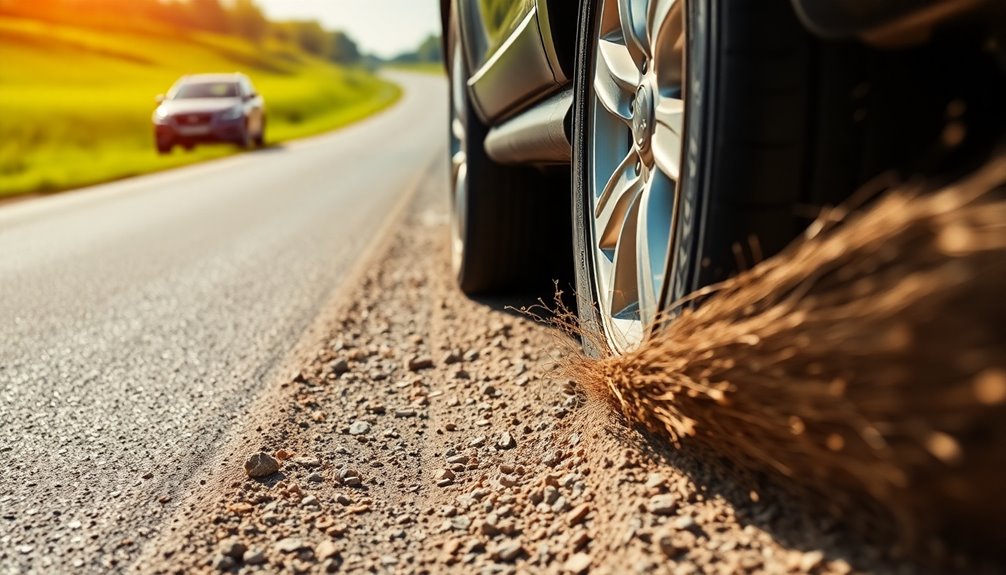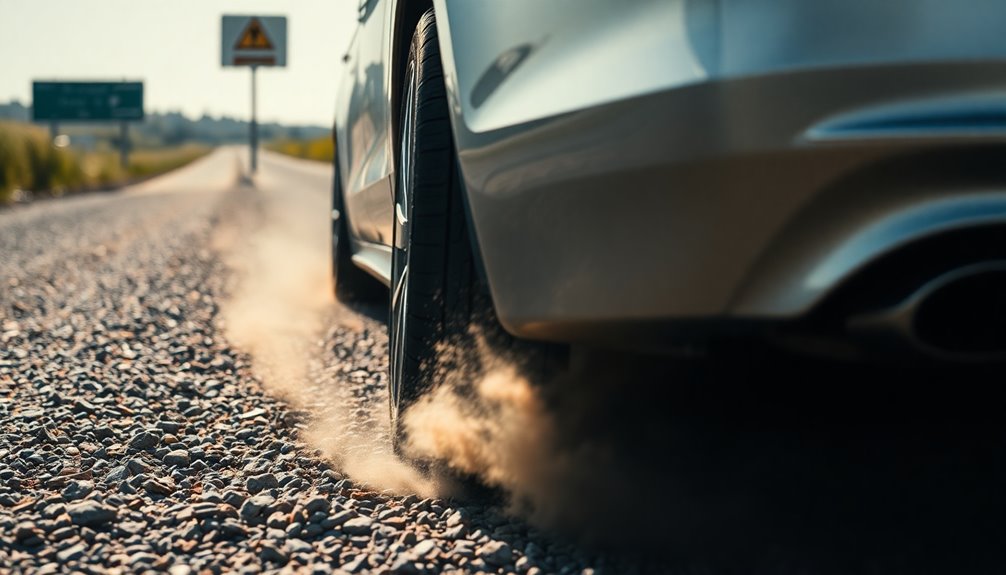If your wheels drop off the pavement and onto the shoulder, stay calm and keep control of your vehicle. Gently reduce your speed to around 25 mph or lower without sudden braking. Check your surroundings for traffic and assess road conditions before merging back onto the pavement. Steer gradually and smoothly, avoiding sharp turns that could compromise your control. Always be aware of nearby vehicles and obstacles on the shoulder. If you can't safely maneuver back, it's best to call for assistance. There's plenty more to know about safe driving techniques in such situations.
Key Takeaways
- Stay calm and gently reduce your speed to around 25 MPH for better vehicle control.
- Gradually steer back onto the pavement using smooth and gentle movements.
- Check mirrors and blind spots to ensure a safe merge back onto the road.
- Avoid hard braking and sharp turns to maintain stability and control.
- If you feel unsafe or unable to maneuver, call for assistance and keep hazard lights on.
Immediate Actions to Take

When your wheels drop off the pavement, the first thing you need to do is stay calm and in control. Gently reduce your speed without braking, as sudden stops can lead to loss of control.
Focus on maintaining control of the vehicle while you assess road conditions and surrounding traffic. Look for any obstacles or vehicles that might pose a risk.
Next, when you feel it's safe, gradually steer back onto the pavement. Avoid making abrupt steering movements, as they can increase the chances of a rollover or skidding. Instead, aim for a smooth shift back onto the roadway.
Before merging, always check your mirrors for nearby vehicles. This guarantees you're aware of your surroundings and can make a safe re-entry.
Remember, taking your time and being aware of your environment is essential during this situation. By following these steps, you'll not only regain control but also navigate back onto the road safely.
Staying composed and methodical in your actions will help you avoid any further complications and keep you and your passengers safe.
Common Mistakes to Avoid

Maintaining control after your wheels drop off the pavement is essential, but it's equally important to avoid common mistakes that can worsen the situation. Here are some vital errors you should steer clear of:
| Mistake | Why to Avoid |
|---|---|
| Hard braking | It can lead to skidding and loss of control. |
| Sharp turns back onto the road | This may tip or roll your vehicle. |
| Speeding up | Increasing speed complicates the situation. |
| Continuing on the shoulder | It could lead to unsafe conditions or collisions. |
When you find yourself in this situation, remember to reduce your speed steadily. Instead of making sudden moves, gently steer to the right to regain control. Focus on making a complete stop if necessary before merging back onto the road. Avoiding distractions is vital during this time; your attention should be solely on regaining control. Each of these actions can greatly reduce the risk of accidents and help you safely get back on track. Stay calm, and don't rush the process.
Essential Safety Tips

When your wheels drop off the pavement, it's essential to maintain a controlled speed to keep your vehicle steady.
Use smooth steering techniques to avoid sudden movements that could lead to losing control.
Always assess surrounding traffic before you steer back onto the road to guarantee a safe changeover.
Maintain Controlled Speed
Control is essential when your wheels drop off the pavement, and managing your speed is one of the most effective ways to maintain it. Start by gradually easing off the gas pedal to reduce speed without abrupt braking. Aim to slow down to 25 MPH or lower for better control. This steady pace helps prevent skidding or losing control when you shift back onto the pavement.
While you're adjusting your speed, always check your mirrors and surroundings. You need to guarantee a safe distance from other vehicles, as this will give you more room to maneuver. Avoid hard braking, as it can lead to a loss of traction, increasing the risk of skidding on the shoulder. Instead, focus on maintaining a steady speed.
As you prepare to return to the road, don't forget to use your turn signals. This communicates your intentions to other drivers, helping to keep everyone safe.
Smooth Steering Techniques
To smoothly steer your vehicle back onto the pavement after your wheels drop off, gently guide the steering wheel straight ahead. This approach helps you maintain control and prevents sudden jerky movements that could lead to losing control.
As you apply smooth steering techniques, focus on aligning your vehicle back onto the road without making sharp turns that might destabilize it. Instead of braking hard, gradually reduce your speed by easing off the gas pedal. Abrupt braking can cause skidding and further loss of control, so a steady decrease in speed is critical.
Verify your tires are clear of the pavement edge before you attempt to re-enter the roadway; this helps prevent scrubbing against the pavement. While steering back onto the road, keep your movements smooth and deliberate. Quick or erratic maneuvers can complicate your re-entry.
Always check for a clear gap in traffic before making your move. This guarantees a safe return without obstructing other vehicles and allows you to regain full control, safely guiding your vehicle back onto the pavement.
Assess Surrounding Traffic
Evaluating surrounding traffic is essential before you attempt to merge back onto the pavement. Start by checking your mirrors and blind spots to confirm no vehicles are close. It's important to assess the speed and distance of approaching traffic; this will help you determine if it's safe to merge.
| Action | Purpose |
|---|---|
| Check mirrors | Identify nearby vehicles |
| Assess speed | Gauge safe merging opportunity |
| Use turn signals | Communicate intentions to others |
| Stay calm | Make better decisions under stress |
You want to maintain a calm demeanor to avoid panic, which can cloud your judgment. Once you've checked the surroundings and feel it's safe, signal your intention to merge. This enhances safety for you and other drivers on the road.
Finally, verify the lane you're entering is clear before making your move. A smooth shift back onto the pavement is critical for your safety and the safety of others. Remember, taking the time to assess your surroundings can make all the difference in a safe return to the road.
Importance of Vehicle Control

When your wheels drop off the pavement, maintaining control is essential to prevent accidents.
You need to reduce your speed gradually and make smooth steering adjustments to guide your vehicle back onto the road.
Staying aware of your surroundings helps guarantee a safe change back to solid ground.
Maintaining Steering Control
Maintaining steering control is essential, especially if your wheels drop off the pavement. When this happens, your first instinct might be to jerk the steering wheel, but that can lead to loss of vehicle control and potential accidents. Instead, focus on maintaining control by gradually reducing your speed without hard braking. This smoother change will help you stay in command of your vehicle.
Use gentle steering motions to align your vehicle back onto the roadway. Avoid sharp turns, as they can create instability or skidding, putting you at greater risk. Keeping a steady grip on the steering wheel is also vital; it helps prevent erratic movements that could worsen the situation and lead to a rollover or crash.
Before you attempt to re-enter the pavement, always assess nearby traffic and road conditions. This will allow you to safely maneuver your vehicle back onto the road without compromising your safety or that of others around you.
Smooth Speed Reduction
Smooth speed reduction is essential for keeping your vehicle under control after your wheels drop off the pavement. To effectively manage this situation, gradually ease off the gas pedal instead of hitting the brakes hard. Sudden braking can cause skidding, making it harder to maintain control. Aim to reduce your speed to around 25 MPH or lower, which facilitates a safe return to the roadway.
As you slow down, make smooth steering adjustments. Abrupt movements can compromise your stability and lead to loss of control.
Awareness of Surroundings
Awareness of your surroundings is vital after your wheels drop off the pavement, as it directly impacts your ability to regain control. By staying alert, you can assess nearby traffic and identify potential hazards that could affect your next move.
Checking your mirrors before making any maneuvers is essential; it guarantees you're aware of vehicles approaching from behind or in adjacent lanes. This knowledge helps you avoid collisions while re-entering the road.
As you prepare to steer back onto the pavement, pay attention to obstacles on the shoulder, such as debris or pedestrians. These hazards can lead to accidents if you're not vigilant.
Monitor the speed and behavior of other vehicles around you; understanding their movements allows you to gauge when it's safe to re-enter without causing disruption.
Additionally, keep an eye out for changes in road conditions, like uneven surfaces or construction zones. Being aware of these factors enhances your ability to regain control effectively.
Assessing Traffic Conditions

When your wheels drop off the pavement, evaluating traffic conditions becomes essential for a safe return to the road.
Start by checking for any oncoming traffic in adjacent lanes. This will help you avoid potential collisions when you decide to merge back onto the pavement.
Keep an eye on the speed and distance of vehicles approaching from behind. You want to guarantee there's enough space for you to maneuver without causing an accident.
Here are a few key points to remember while evaluating traffic conditions:
- Use your mirrors to monitor the position of other vehicles around you.
- Look for gaps in traffic that provide a clear opportunity to merge back safely.
- Stay vigilant for pedestrians or cyclists who may be near the shoulder.
Techniques for Safe Re-entry

Re-entering the road safely after your wheels have dropped off the pavement requires a careful blend of control and awareness.
First, gradually reduce your speed without braking sharply as you approach the shoulder of the road. This helps maintain control and prepares you for a smooth shift. Before you carefully turn back onto the pavement, assess nearby traffic conditions to avoid potential collisions.
To execute the maneuver, verify your vehicle is at a safe speed—ideally around 25 MPH or lower—to match the flow of traffic. Use a smooth, gentle steering motion as you make your move. Avoid speed and turn sharply, as abrupt movements can lead to loss of control.
As you approach the roadway, always check your mirrors and blind spots for any oncoming vehicles. This confirms that it's safe to merge back onto the pavement.
Once you've confirmed the coast is clear, re-enter the road confidently while maintaining that controlled speed. Following these techniques will help you shift safely, keeping both you and other drivers secure on the road.
When to Seek Assistance

Knowing when to seek assistance is essential if you find yourself unable to safely return to the road after your wheels have dropped off the pavement. If your vehicle is positioned safely away from the roadway, you're in a better spot to wait for help.
Here are a few scenarios when you should definitely call for assistance:
- If you can't maneuver your vehicle back onto the pavement.
- If you're stuck in a dangerous position close to traffic.
- If you feel uncomfortable or unsafe waiting alone.
When you call for help, use resources like AAA and provide your exact location and situation.
While waiting for assistance, keep your hazard lights on to alert other drivers and increase your visibility. If it's safe, remain inside your vehicle; it's often the safest place to be until help arrives.
Always prioritize your safety and the safety of others on the road. Making the decision to request assistance promptly can prevent further complications and guarantee you're not left stranded longer than necessary.
Frequently Asked Questions
What Should You Do if a Wheel Drops off the Shoulder?
If a wheel drops off the shoulder, don't panic. You should gently ease off the accelerator, avoiding sudden braking to keep control.
Keep an eye on your surroundings and assess the traffic before making any moves. When it's safe, gradually steer back onto the road, ensuring your tires align with the pavement.
Always check your mirrors to confirm it's clear before re-entering, helping to avoid any potential accidents. Stay calm and focused!
What Should You Do if Your Car Drifts Onto the Shoulder of the Road?
If your car drifts onto the shoulder, don't panic. Gently reduce your speed without slamming on the brakes to keep control.
Avoid sudden steering movements; instead, smoothly guide your vehicle back onto the pavement when it's safe. Always check your mirrors and assess nearby traffic before merging back onto the road.
Aim to slow down to around 25 mph or less to minimize the risk of losing control during the maneuver.
When the Right Front Wheels of Your Vehicle Drop off the Pavement Onto the Shoulder, You Should Brake Firmly Then Re-Enter the Roadway.?
Braking firmly when your right front wheels drop off the pavement isn't a good idea; it could cause you to lose control.
Instead, gently ease off the gas to let your vehicle slow down naturally. Keep your steering steady and straight, avoiding sudden movements.
Once you've decelerated, check for traffic gaps and, when it's safe, smoothly steer back onto the pavement without sharp turns, ensuring stability and control.
What Is the First Thing You Should Do When Your Wheels Move off the Pavement?
So, your wheels have decided to audition for a role on the shoulder? First, take a deep breath—panicking won't win you an Oscar.
Gradually ease off the gas; slamming the brakes is a sure way to turn your car into a drama queen.
Keep your steering steady and straight, like you're on a leisurely drive.
Only when it's safe, gently guide your vehicle back onto the pavement. Easy peasy!
Conclusion
So, if your wheels drop off the pavement, don't panic like you've just discovered a dragon in your backyard! You've got this! Stay calm, check your surroundings, and follow those safety tips to glide back onto the road like a pro. Remember, it's not the end of the world—just a little detour in your epic journey! If things get hairy, don't hesitate to call for help before your car turns into a runaway spaceship!









